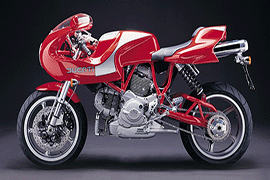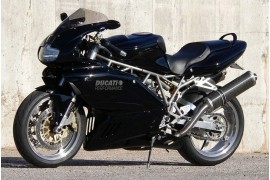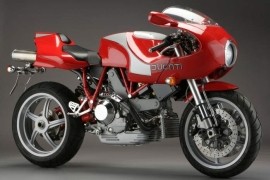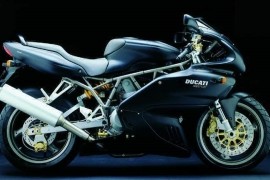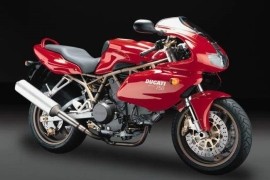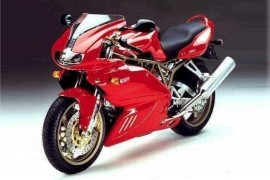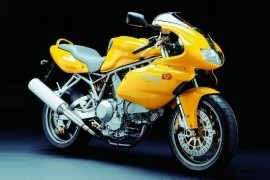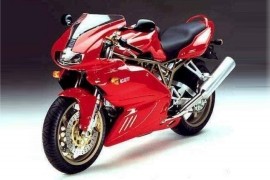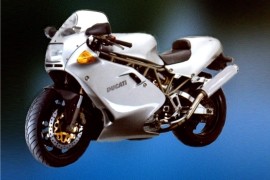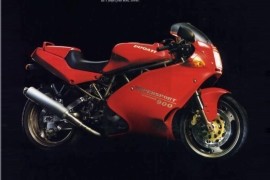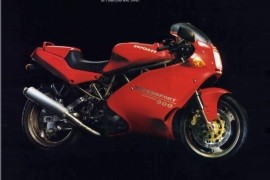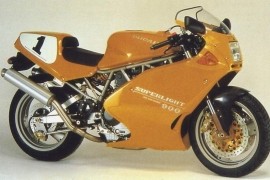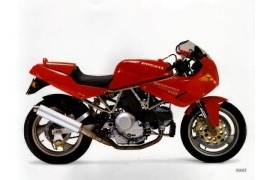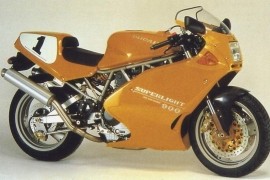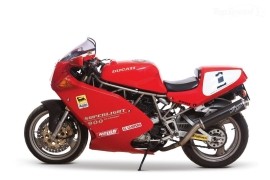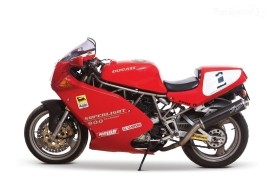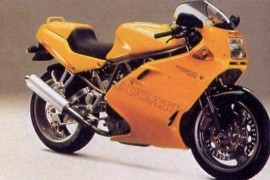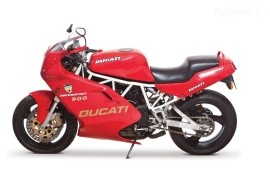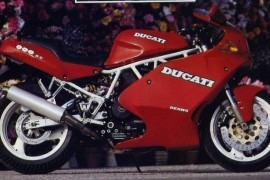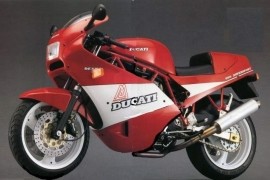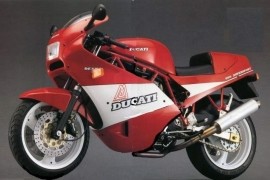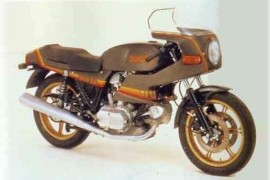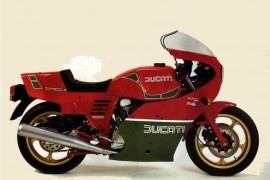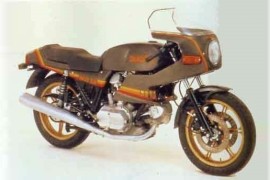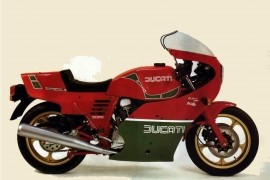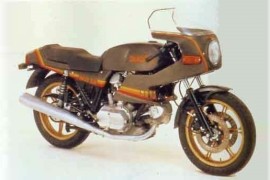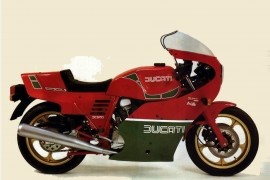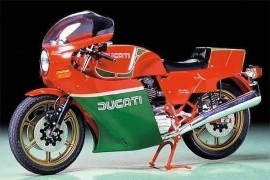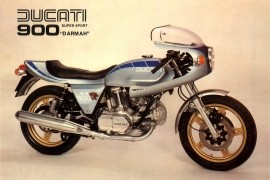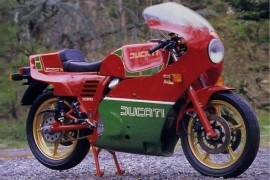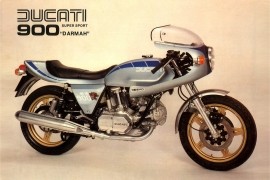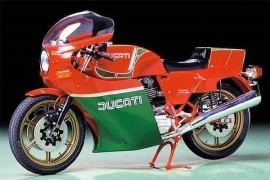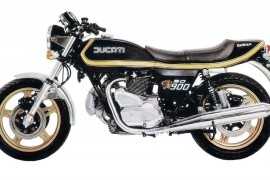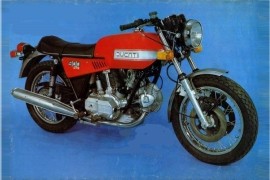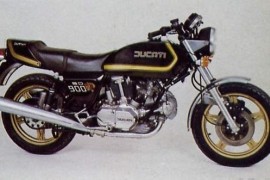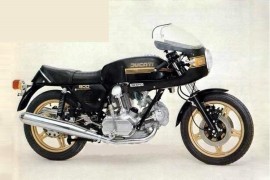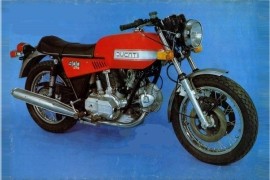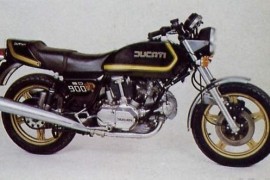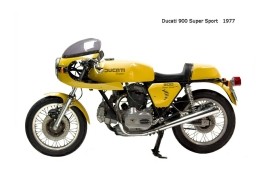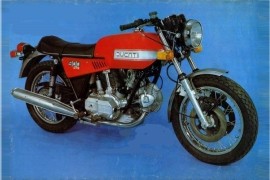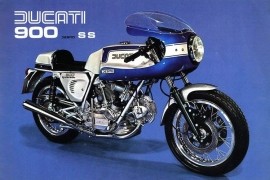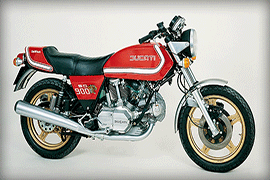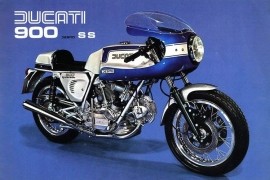DUCATI 900 Models/Series Timeline, Specifications & Photos
First production year: 1975
The new millennium saw Ducati introduce many innovations. The company, thanks to a new commercial structure able to strengthen the brand and extend its presence across the world, was clearly paving its way towards the future.
The 2001 MY Ducati 900SS is a powerful yet agile machine, sure to fit the taste and needs for a wide category of riders. It has fittings such as Brembo brakes with dual front discs and a single disc in the rear, a dual seat, a passenger grab handle, a dual exhaust system, a full-fairing with a small windscreen, a Showa suspension package with a 43mm inverted fork and an adjustable monoshock in the rear, a digital instrument cluster and a steel trestle frame.
It also boasts a maximum power output of 80 horsepower and 79 Nm of torque from it-s fuel-injected, four-stroke, air-cooled, 904cc, 90-degree V-Twin powerhouse that was paired to a six-speed manual transmission with a chain final drive.
The 2000 MY Ducati 900MHE has, at its heart, an air-cooled, four-stroke, 904cc, 90-degree V-Twin desmodromic engine paired to a six-speed manual transmission, and can reach a maximum power output of 75 horsepower and 76 Nm of torque.
Also, it comes with features such as a 43mm upside-down telescopic fork, a Paioli adjustable rear monoshock, dual front disc brakes, a half-fairing with a windscreen, a single seat with lumbar support, an under-seat exhaust system, cast-aluminium wheels, a single-sided swingarm, a large, round headlight and an analogue instrumentation panel.
The 2000 MU Ducati 900 Sport, unlike its SS sibling, has a new engine mapping and improved suspension settings to make for a more responsive, manageable and fun machine. It comes with Brembo brakes with dual front discs and a single disc in the rear, a dual seat, a passenger grab handle, a dual exhaust system, a full-fairing with a small windscreen, a Showa suspension package with a 43mm inverted fork and an adjustable monoshock in the rear, a digital instrument cluster and a steel trestle frame.
In the engine department it sports a four-stroke, air-cooled, 904cc, 90-degree V-Twin desmodromic powerhouse, mated to a six-speed manual transmission with a chain final drive, and can reach a maximum power output of 80 horsepower and 79 Nm of torque.
The 2000 MY Ducati 900SS Half-fairing is one of the most sought after machines in its class, and is sure to fit the taste for those riders who want a naked machine with sportbike performance. It comes with Brembo brakes with dual front discs and a single disc in the rear, a dual seat, a passenger grab handle, a dual exhaust system, a half-fairing with a small windscreen, a Showa suspension package with a 43mm inverted fork and an adjustable monoshock in the rear, a digital instrument cluster and a steel trestle frame.
In the engine department it sports a four-stroke, air-cooled, 904cc, 90-degree V-Twin desmodromic powerplant, paired to a six-speed manual transmission with a chain final drive, and can reach a maximum power output of 80 horsepower and 77 Nm of torque.
The 2000 MY Ducati 900SS has, at its heart, an air-cooled, four-stroke, 904cc, 90-degree V-Twin desmodromic engine, paired to a six-speed manual transmission, and can reach a maximum power output of 80 horsepower and 77 Nm of torque.
Also, it comes with features such as Brembo brakes with dual front discs and a single disc in the rear, a dual seat, a passenger grab handle, a dual exhaust system, a full-fairing with a small windscreen, a Showa suspension package with a 43mm inverted fork and an adjustable monoshock in the rear, a digital instrument cluster and a steel trestle frame.
The 1999 MY Ducati 900SS Half-fairing is a machine that offers superbike performance levels in a naked package. It has, at its heart, an air-cooled, four-stroke, 904cc, 90-degree V-Twin desmodromic powerhouse, mated to a six-speed manual transmission with a chain final drive, that produces a claimed 80 horsepower and 77 Nm of torque.
It also comes with features such as Brembo brakes with dual front discs and a single disc in the rear, a dual seat, a passenger grab handle, a dual exhaust system, a half-fairing with a small windscreen, a Showa suspension package with a 43mm inverted fork and an adjustable monoshock in the rear, a digital instrument cluster and a steel trestle frame.
The 1999 MY Ducati 900SS has seen upgrades in almost every department, significantly increasing its desirability among House of Bologna fans, and not only. The most obvious change is in its visual department, benefiting from a redesigned bodywork, and new paint and graphic schemes, to fit all rider tastes.
Also, it has an Electronic Fuel Injection (EFI) system, instead of dual carburetors, a tweaked suspension package, new Brembo brakes, new wheels and tires, and improved ergonomics for a higher comfort level.
The 1998 Ducati 900SS FE, which stands for Final Edition, is the last model year for the carburetor-equipped 900SS, before it was replaced that same year. This edition was more like the 900SL, and was equipped with a special silver single seat, a modified engine, a race-style exhaust system, blacked-out cast-aluminium wheels, a carbon fiver rear fender, dashboard cover and countershaft cover, and was limited to only 300 units on the American market.
In the engine department it sports an air-cooled, four-stroke, 904cc, 90-degree V-Twin desmodromic powerhouse that was mated to a six-speed manual transmission with a chain final drive, and could reach a maximum power output of 84 horsepower and 84 Nm of torque.
The 1998 MY Ducati 900SS boasts a maximum power output of 84 horsepower and 84 Nm of torque from its four-stroke, air-cooled, 904cc, 90-degree V-Twin desmodromic engine, that was mated to a six-speed manual transmission with a chain final drive.
Also, it comes with a full-fairing with a small windscreen, a single seat, a dual exhaust system, cast-aluminium wheels, Brembo brakes with dual front discs and a single disc in the rear, a steel, trellis frame, analogue instrumentation dials and a Showa suspension package composed of a 41mm fully-adjustable upside-down fork and an adjustable monoshock in the rear.
The 1996 Ducati 900SS has fittings such as a full-fairing with a small windscreen, a single seat, a dual exhaust system, cast-aluminium wheels, Brembo brakes with dual front discs and a single disc in the rear, a steel, trellis frame, analogue instrumentation dials and a Showa suspension package composed of a 41mm fully-adjustable upside-down fork and an adjustable monoshock in the rear.
In the engine department it sports a four-stroke, air-cooled, 904cc, 90-degree V-Twin powerplant, paired to a six-speed manual transmission with a chain final drive, and can produce a claimed 84 horsepower and 84 Nm of torque.
This model can also be purchased with a half-fairing.
The 1996 Ducati 900SL Super Light is one of the most agile sportbikes available on the market up to date. It comes with a 41mm Showa fully-adjustable upside-down fork in the front, an adjustable monoshock in the rear with a progressive linkage, a full-fairing, a single seat, a dual exhaust system, a carbon-fiber mudguard and clutch cover, a windscreen and an analogue instrumentation panel. The most impressive aspect of this machine is its lightness, tipping the scale at just 176 kg.
Also, it is powered by a four-stroke, air-cooled, 904cc, 90-degree desmodromic V-Twin, paired to a six-speed manual transmission with a chain final drive, and can produce a claimed 78 horsepower and 84 Nm of torque.
The 1995 Ducati 900SS has, at its heart, an air-cooled, four-stroke, 904cc, 90-degree V-Twin powerhouse that was mated to a six-speed manual transmission and could reach a maximum power output of 84 horsepower and 84 Nm of torque.
Also, it comes with features such as a half-fairing with a small windscreen, a single seat, a dual exhaust system, cast-aluminium wheels, Brembo brakes with dual front discs and a single disc in the rear, a steel, trellis frame, analogue instrumentation dials and a Showa suspension package composed of a 41mm fully-adjustable upside-down fork and an adjustable monoshock in the rear.
The 1995 Ducati 900SL Super Light boasts a maximum power output of 78 horsepower and 84 Nm of torque from its four-stroke, air-cooled, 904cc, L-Twin desmodromic powerplant that was mated to a six-speed manual transmission with a chain final drive.
This sportbike also comes with a 41mm Showa fully-adjustable upside-down fork in the front, an adjustable monoshock in the rear with a progressive linkage, a full-fairing, a single seat, a dual exhaust system, a carbon-fiber mudguard and clutch cover, a windscreen and an analogue instrumentation panel. The most impressive aspect of this machine is its lightness, tipping the scale at just 176 kg.
The 1994 Ducati 900SL Super Light has fittings such as a 41mm Showa fully-adjustable upside-down fork in the front, an adjustable monoshock in the rear with a progressive linkage, a full-fairing, a single seat, a dual exhaust system, a carbon-fiber mudguard and clutch cover, a windscreen and an analogue instrumentation panel.
In the engine department it sports an air-cooled, four-stroke, 904cc, 90-degree V-Twin desmodromic powerplant, mated to a six-speed manual transmission with a chain final drive, that can produce a claimed 78 horsepower and 84 Nm of torque.
The 1993 Ducati 900SL Super Light tips the scale at just 176 kg, making it one of the lightest machines in its class. It has, at its heart, an air-cooled, four-stroke, 904cc, 90-degree V-Twin desmodromic powerhouse paired to a six-speed manual transmission, and can reach a maximum power output of 78 horsepower and 84 Nm of torque.
It also comes with features such as a 41mm Showa fully-adjustable upside-down fork in the front, an adjustable monoshock in the rear with a progressive linkage, a full-fairing, a single seat, a dual exhaust system, a carbon-fiber mudguard and clutch cover, a windscreen and an analogue instrumentation panel.
If you're on the market for a powerful sportbike, that also has the trademark Italian craftsmanship and attention to detail, then the 1993 Ducati 900SS may be the right choice for you. It has, at its heart, an air-cooled, four-stroke, 904cc, 90-degree V-Twin desmodromic engine, mated to a six-speed manual transmission, and can reach a maximum power output of 84 horsepower and 84 Nm of torque.
The most notable features for this machine would be the fully-adjustable, 40mm Marzocchi upside down fork, an adjustable Marzocchi monoshock with a progressive linkage as a rear suspension, Brembo brakes with dual front disc brakes and a single disc in the rear, a single seat, a full-fairing with a small windscreen and die-cast aluminium wheels.
The Italian engineers from the House of Bologna have designed the 1992 Ducati 900SS for riders who make zero compromises when it comes to performance. It has features such as a fully-adjustable, 40mm Marzocchi upside down fork, an adjustable Marzocchi monoshock with a progressive linkage as a rear suspension, Brembo brakes with dual front disc brakes and a single disc in the rear, a single seat, a full-fairing with a small windscreen and die-cast aluminium wheels.
In the engine department, it is powered by a four-stroke, air-cooled, electronically-injected, 904cc, 90-degree V-Twin powerhouse that was mated to a six-speed manual transmission with a chain final drive, and can produce a claimed 84 horsepower and 84 Nm of torque.
The 1992 MY Ducati 900SS boasts a maximum power output of 84 horsepower and 84 Nm of torque from its four-stroke, air-cooled, 904cc, 90-degree V-Twin powerplant that was paired to a six-speed manual transmission with a chain final drive.
In addition, it comes with a fully-adjustable, 40mm Marzocchi upside down fork, an adjustable Marzocchi monoshock with a progressive linkage as a rear suspension, Brembo brakes with dual front disc brakes and a single disc in the rear, a single seat, a full-fairing with a small windscreen and die-cast aluminium wheels.
The 1990 Ducati 900SS is, arguably, one of the most powerful machines in its class, and also boasted a dry weight of only 180 kg. Also, it had fittings such as a fully-adjustable, 40mm Marzocchi upside down fork, an adjustable Marzocchi monoshock with a progressive linkage as a rear suspension, Brembo brakes with dual front disc brakes and a single disc in the rear, a single seat, a full-fairing with a small windscreen and die-cast aluminium wheels.
In the engine department it sports a four-stroke, air-cooled, 904cc, 90-degree V-Twin powerhouse mated to a six-speed manual transmission with a chain final drive, that produces a claimed 84 horsepower and 84 Nm of torque.
The 1989 Ducati 900SS has, at its heart, an air-cooled, four-stroke, 904cc, 90-degree V-Twin powerplant paired to a six-speed manual transmission, and can reach a maximum power output of 84 horsepower and 84 Nm of torque.
Also, it comes with features such as a fully-adjustable, 40mm Marzocchi upside down fork, an adjustable Marzocchi monoshock with a progressive linkage as a rear suspension, Brembo brakes with dual front disc brakes and a single disc in the rear, a single seat, a full-fairing with a small windscreen and die-cast aluminium wheels.
The 1984 Ducati 900S2 boasts a maximum power output of 80 horsepower and 86 Nm of torque from its four-stroke, air-cooled, 864cc, desmodromic V-Twin powerhouse, that was paired to a five-speed manual transmission with a chain final drive.
In addition, it has fittings such as a Marzocchi suspension package, composed of a 38mm telescopic front fork and adjustable dual shock absorbers in the rear, Brembo brake calipers mounted on its two front disc brakes, cast-aluminium wheels, a chromed, dual exhaust system, a half-fairing with a windshield and a large, round headlight.
The Ducati 900 MHR was a race replica made by Ducati from 1979 until 1984. The bike was derived from the 900 SS (Super Sport) and was made in limited numbers. The maker manufactured 5,153 900 MHR models and 1,038 1000 MHR versions.
In 1984, the Italian motorcycle manufacturer launched the Ducati 900 MHR, a race replica motorcycle made after Mike Hailwood won the Tourist Trophy at the Isle of Men in 1978. The replica was very similar to the actual racing motorcycle, which was actually a factory 900 SS model.
In the visual department, the 1984 model was similar to previous models, packing standard features, such as a full fairing with a round headlight up front, a large windscreen, a single seat with lumbar support, a center stand, and lightweight five-spoke aluminum wheels.
The bike was built around a steel trellis frame with a 38 mm Marzocchi telescopic fork on the front and twin adjustable Marzocchi shock absorbers on the rear, offering excellent suspension performance and handling.
The braking performance was handled by two 280 mm discs on the front wheel engaged by two-piston calipers and a 260 mm disc on the rear wheel tied to a single-piston caliper, providing optimum stopping power.
As for the power figures, the 1984 Ducati 900 MHR had its heartbeat set by an 864cc four-stroke V-twin air-cooled engine that delivered an output power of 80 hp with a peak force at 7,500 rpm and 85 Nm (63 lb-ft) torque at 5,800 rpm.
The 1983 Ducati 900S2 comes standard with a Marzocchi suspension package, composed of a 38mm telescopic front fork and adjustable dual shock absorbers in the rear, Brembo brake calipers mounted on its two front disc brakes, cast-aluminium wheels, a chromed, dual exhaust system, a half-fairing with a windshield and a large, round headlight.
In the engine department it sports an air-cooled, four-stroke, 864cc, 90-degree V-Twin desmodromic engine mated to a five-speed manual transmission with a chain final drive, that can produce a claimed of 80 horsepower and 86 Nm of torque.
The Ducati 900 MHR, also known as the 900 Mike Hailwood Replica, was a motorcycle made by Ducati from 1979 until 1984. The bike was based on the Ducati 900 Super Sport.
It was born after Mike Hailwood won the Tourist Trophy on the Isle of Man in 1978, riding a powerful factory-fitted 900/SS.
In 1983, the Italian motorcycle maker released the Ducati 900 MHR, a motorcycle that packed the same specifications as the previous model, with several modifications for the 1983 model year.
The 1983 model received several modifications, the biggest being the adoption of an electric starter. In addition to the button-start engine, the bike received redesigned graphics, the brake calipers were moved behind the fork sliders, and a hydraulically controlled clutch was updated from wet to dry.
Besides its revised graphics, the bike's aesthetic was identical to previous models, packing standard features, such as a full fairing, a round headlight, a large windscreen, a single seat with lumbar support, a side stand, twin side-mounted rear shocks, a dual exhaust system, and five-spoke lightweight aluminum wheels.
As for the power figures, the 1983 Ducati 900 MHR had its soul brought to life by an 864cc four-stroke air-cooled V-twin engine managed by two Dell'Orto carburetors, boasting 80 hp with maximum strength at 7,500 rpm and 85 Nm (63 lb-ft) torque at 5,800 rpm.
The 1982 Ducati 900S2 has, at its heart, an air-cooled, four-stroke, 864cc, 90-degree V-Twin desmodromic powerplant that was paired to a five-speed manual transmission, and can reach a maximum power output of 80 horsepower and 86 Nm of torque.
Also, it has fittings such as a Marzocchi suspension package, composed of a 38mm telescopic front fork and adjustable dual shock absorbers in the rear, Brembo brake calipers mounted on its two front disc brakes, cast-aluminium wheels, a chromed, dual exhaust system, a half-fairing with a windshield and a large, round headlight.
In 1982, the Italian motorcycle manufacturer launched the Ducati 900 MHR (Mike Hailwood Replica), a race replica motorcycle with the same looks as the real motorcycle that brought home the Tourist Trophy won by Mike Hailwoodat the Isle of Man in 1978.
The last upgrade of the 900 MHR was in 1981 when the front brake discs gained 20 mm in diameter, revised graphics on the fairing and fuel tank, and a Mike Hailwood Replica inscription on the top of the fairing, while the later models were fitted with a two-part fairing instead of one.
Visually, the bike was similar to previous models, packing standard features such as a full fairing, a round headlight up front, a large windscreen, a single seat with lumbar support, a dual exhaust system with a silencer on each side, and six-spoke lightweight cast alloy wheels.
In the performance department, the 1982 Ducati 900 MHR had installed an 864cc four-stroke air-cooled V-twin engine fed by two Dell'Orto carburetors, delivering an output power of 80 hp with a peak force at 7,500 rpm and 85 Nm (63 lb-ft) torque at 5,800 rpm.
The bike's engine was married to a five-speed manual transmission that spun the rear wheel through a final chain drive, pushing the motorcycle to a top speed of 222 kph (138 mph).
From top speed to a complete stop, the bike relied on two 280 mm discs on the front wheel coupled to dual-piston calipers and a 260 mm disc on the rear wheel tied to a single-piston caliper.
In 1981, the Italian bike maker released the Ducati 900 MHR, also known as the 900 Mike Hailwood Replica. The bike was an exact version of the machine Mike Hailwood rode in the 1978 Isle of Man race, winning the Tourist Trophy.
It was in its third year of production, boasting the same visual, technical, and performance specifications as previous models without any modifications whatsoever, except for a 20 mm larger front brake disc and revised tank graphics. Also, the bike was fitted with a kickstarter instead of an electric one.
Visually, the bike was similar to previous models, packing standard features, like a full fairing with a round headlight up front, a large windscreen especially designed for the rider to tuck his head in during high speeds, a single seat, and five-spoke alloy wheels.
The motorcycle was manufactured around a steel trellis frame with a 38 mm Marzocchi telescopic fork on the front and dual adjustable shock absorbers on the rear, providing excellent suspension performance and handling.
The bike's wheels were fitted with two 280 mm brake discs on the front coupled to dual-piston calipers and a 260 mm disc on the rear wheel tied to a single-piston caliper, providing excellent stopping power.
The 1981 Ducati 900 MHR packed the same 864cc four-stroke air-cooled V-twin engine as previous models, fed by two Dell'Orto carburetors, delivering an output power of 80 hp at 7,500 rpm and 85 Nm (63 lb-ft) torque at 5,800 rpm.
The 1981 Ducati 900SD Darmah is mainly addressed to those riders value performance over anything else. It comes equipped with a four-stroke, air-cooled, 864cc, L-Twin desmodromic engine, mated to a five-speed manual transmission, that can reach a maximum power output of 65 horsepower at 7500 rpm.
Standard features include dual front disc brakes, a telescopic front fork, adjustable, dual Marzocchi shocks as a rear suspension, a dual seat, a chromed, dual exhaust system, cast-aluminium wheel,s a large, round headlight, analogue instrumentation dials and a blacked-out, steel frame.
In 1980, the Italian motorcycle manufacturer launched the Ducati 900 MHR (Mike Hailwood Replica), a motorcycle in its second year of production featuring the same looks as the actual machine that won the Isle of Man Tourist Trophy in 1978.
The 1980 model packed the exact technical, visual, and performance specifications as the previous model without any modifications whatsoever, except for a six liter larger fuel tank and different rims. The bike best suited those riders who wanted more performance above anything else.
In the visual department, the bike was represented by standard features, such as a full fairing with a large windscreen, a round headlight up front, a single seat, a center stand, a dual exhaust system, and five-spoke cast aluminum wheels.
The bike was built around a trellis steel frame with a 38 mm Marzocchi telescopic fork on the front and dual adjustable shock absorbers on the rear, delivering excellent suspension performance and handling.
As for the braking power, the bike packed two 280 mm discs with two-piston calipers on the front wheel and a 260 mm disc on the rear wheel engaged by a single-piston caliper, providing excellent stopping performance.
In the performance department, the bike had installed an 864cc four-stroke V-twin air-cooled engine underneath its fuel tank fed by two Dell'Orto carburetors, boasting 80 hp with a peak force at 7,500 rpm and 85 Nm (63 lb-ft) torque at 5,800 rpm.
The Italian engineers from Borgo Panigale have designed the 1980 Ducati 900SD Darmah for those riders that want superior performance from their machine. It comes equipped with dual front disc brakes, a telescopic front fork, adjustable, dual Marzocchi shocks as a rear suspension, a dual seat, a chromed, dual exhaust system, cast-aluminium wheel,s a large, round headlight, analogue instrumentation dials and a blacked-out, steel frame.
In the engine department, it sports a four-stroke, air-cooled, 864cc, 90-degree V-Twin powerplant paired to a five-speed manual transmission with a chain final drive that can produce a claimed 65 horsepower at 7500 rpm.
The Ducati 900 MHR, also called 900 Mike Hailwood Replica, was a motorcycle manufactured by Ducati from 1979 until 1984. The bike was derived from the Ducati 900 Super Sport.
The bike was born after Mike Hailwood won the Tourist Trophy in the Isle of Man in 1978 on a powerful factory 900/SS. After this win, the Italian maker produced a series of 900/SS with similar looks to the actual machine.
The bike's aesthetics were very similar to the Ducati 860 MHR, with a smooth red and green fairing and a steel fuel tank with fiberglass on its lower part. In addition, the bike came with a kickstarter instead of an electric one.
Also, the maker allowed buyers to choose the diameter of the valves. There were two options: 42 mm intake and 38 mm exhaust or 44 mm intake and 40 exhaust. In addition, the buyers could choose the brand of the silencers, Silentium or Conti.
In 1979, the Italian motorcycle maker released the Ducati 900 MHR, a race replica based on the 860 MHR championship-winning machine that featured a full fairing, a large windscreen, a single seat, a dual exhaust system with a muffler on each side, a center stand, and five-spoke alloy wheels.
As for performance, the 1979 Ducati 900 MHR had installed an 846cc four-stroke air-cooled V-twin engine underneath its fairing, delivering an output power of 80 hp with a peak force at 7,500 rpm and 85 Nm (63 lb-ft) torque at 5,800 rpm.
The 1979 Ducati 900SD Darmah boasts a maximum power output of 65 horsepower at 7500 rpm from its four-stroke, air-cooled, 864cc, 90-degree V-Twin powerplant mated to a five-speed manual transmission with a chain final drive.
In addition, it has fittings such as dual front disc brakes, a telescopic front fork, adjustable, dual Marzocchi shocks as a rear suspension, a dual seat, a chromed, dual exhaust system, cast-aluminium wheel,s a large, round headlight, analogue instrumentation dials and a blacked-out, steel frame.
The 1979 Ducati 900GTS boasts a maximum power output of 65 horsepower and 73 Nm of torque from its air-cooled, four-stroke, 864cc, L-Twin powerhouse that was mated to a five-speed manual transmission with a chain final drive.
Also, it has comes with a telescopic front fork coupled to Marzocchi dual shock absorbers in the rear, dual front disc brakes, a rear drum brake, laced wheels, a chromed, dual exhaust system, a dual seat, a large, round headlight, front and rear blinkers and an analogue instrument cluster.
The 1978 Ducati 900SD Darmah comes with features such as dual front disc brakes, a telescopic front fork, adjustable, dual Marzocchi shocks as a rear suspension, a dual seat, a chromed, dual exhaust system, cast-aluminium wheel,s a large, round headlight, analogue instrumentation dials and a blacked-out, steel frame.
In the engine department it sports an air-cooled, four-stroke, 864cc, 90-degree V-Twin desmodromic powerhouse paired to a five-speed manual transmission that can produce a claimed 74 horsepower at 7500 rpm.
The Ducati 900SS was a half-faired motorcycle that debuted in 1975 alongside the sleeved-down 750 model. Both machines were made in 250 units each and had similar prices, which made the 750 model an unwanted machine. A few 750 machines were shipped to Germany and Australia, while others remained in Italy for racing applications.
In 1978, the Italian motorcycle manufacturer launched the Ducati 900SS, a motorcycle in its fourth year of production that received several modifications. Improving its overall performance.
Although the 1978 models looked identical to previous models, several modifications were introduced, including changes to the engine that solved problems with the cranks, an improved electronic system, and other tweaks that made the bike run more efficiently.
The most notable modification was the redesigned gear shifter that made life easier for owners. Also, the bike came with a dual seat, while the solo seat was available as an option and a lockable toolbox.
The 1978 models were the last machine that retained close links with Imola racers and the last ones to pack wire-spoke wheels. Also in 1978, a Ducati 900 Super Sport motorcycle, ridden by the former World Champion Mike Hailwood in the Isle of Man TT Formula One race, brought home the victory.
As for the performance figures, the 1978 Ducati 900SS had installed an 864cc four-stroke air-cooled V-twin engine underneath its fuel tank that delivered 67 hp with a peak force at 7,500 rpm.
The 1978 Ducati 900GTS comes with features such as a telescopic front fork coupled to Marzocchi dual shock absorbers in the rear, dual front disc brakes, a rear drum brake, laced wheels, a chromed, dual exhaust system, a dual seat, a large, round headlight, front and rear blinkers and an analogue instrument cluster.
In the engine department it comes equipped with an air-cooled, four-stroke, 864cc, 90-degree V-Twin powerplant mated to a five-speed manual transmission, that can reach a maximum power output of 65 horsepower and 73 Nm of torque.
The 1977 MY Ducati 900SD Darmah has, at its heart, an air-cooled, four-stroke, 864cc, 90-degree V-Twin powerplant mated to a five-speed manual transmission that can produce a claimed 74 horsepower at 7500 rpm.
Standard fittings include dual front disc brakes, a telescopic front fork, adjustable, dual Marzocchi shocks as a rear suspension, a dual seat, a chromed, dual exhaust system, cast-aluminium wheel,s a large, round headlight, analogue instrumentation dials and a blacked-out, steel frame.
The Ducati 900SS was a half-faired motorcycle manufactured by Ducati since 1975 alongside the sleeved-down 750 model. Both machines were made in 250 units each and were virtually identical with similar prices. Most of the 750 models were shipped to Australia and Germany, while others remained in Italy for racing purposes.
In 1977, the Italian motorcycle manufacturer launched the Ducati 900SS, a half-faired motorcycle in its third year of production. Some changes made to the 950SS models included quieter mufflers, a relocated gear shifter, and new footpegs to comply with global legislation.
The bike packed the same standard features as its predecessors, with a rounded half fairing, a large windscreen, a large, round headlight, a single seat with lumbar support, a dual exhaust system with a muffler on each side, wire-spoke wheels, and a center stand.
As for the power figures, the 1977 Ducati 900SS took its muscles from an 864cc four-stroke air-cooled V-twin engine fed by two DelOrto carburetors, boasting 80 hp with a peak force at 7,500 rpm.
The bike's engine was coupled to a five-manual transmission with a wet multi-plate clutch and a final chain drive, spinning the rear wheel to a top speed of 217 kph (135 mph).
The ride was softened by a 38 mm Marzocchi fork on the front and dual side-mounted shock absorbers on the rear. The stopping power was achieved by two 280 mm discs on the front wheel and a 260 mm disc on the rear wheel.
The 1977 Ducati 900GTS is a sport-oriented, classic two-wheeler from the House of Borgo Panigale that had, at its heart, an air-cooled, four-stroke, 864cc, 90-degree V-Twin powerhouse paired to a five-speed manual transmission, and can produce a claimed 65 horsepower and 73 Nm of torque.
Standard fittings include a telescopic front fork coupled to Marzocchi dual shock absorbers in the rear, dual front disc brakes, a rear drum brake, laced wheels, a chromed, dual exhaust system, a dual seat, a large, round headlight, front and rear blinkers and an analogue instrument cluster.
In 1976, the Italian motorcycle manufacturer launched the Ducati 900SS, a half-faired machine that debuted in 1975. The bike was in its second year of production and had no modifications whatsoever.
Against the 1974 US regulations specifying that all motorcycles should have the shift lever on the left side of the engine, the Ducati 900SS continued to use a right side-mounted gear shifter.
Several models were delivered to the American market with the right side-mounted shifter.
Alongside the 900SS, the maker also manufactured the Ducati 750. The 750 model had a similar price to the 950SS and produced a few motorcycles that mainly were delivered to Australia, and Germany or remained in Italy for racing purposes.
In the visual department, the 1976 Ducati 900SS was identical to the previous model, packing the same standard features, such as a half fairing with a large, round headlight, a large windscreen, a single seat with lumbar support, a dual exhaust system, and lightweight wire-spoke wheels.
As for the power figures, the 1976 Ducati 900SS had its heartbeat set by an 864cc four-stroke V-twin air-cooled engine managed by two DelOrto PHM carburetors, delivering 80 hp with maximum strength at 7,500 rpm.
The bike's power was handled by a five-speed manual transmission with a wet multi-plate clutch and final chain drive, pushing the motorcycle to 217 kph (135 mph).
After the round case twins 750 GT, Sport and Super Sport Desmo entered the scene, Ducati management found that the line-up lacked a super sport bike capable of competing with the Japanese superbikes with over 750 cc and the Ducati 900 Super Sport was developed to fill that gap.
The Ducati Supersport and SS were a series of air-cooled desmodromic L-twin powered motorcycles manufactured by Ducati from 1988. The name came from the 1973 Ducati 750 Super Sport and the 1975 Ducati 750 and 900 Super Sport.
In 1975, the Italian motorcycle manufacturer launched the Ducati 900SS alongside the sleeved-down Ducati 750. The maker made 250 units each, but both machines were virtually identical.
The 1975 Ducati 900SS continued to use the right-side gear shifter, unlike the 1974 US regulations that said the gear shifter should be on the left side of the engine. However, several machines with a right-side shifter entered the American market.
In the visual department, the Ducati 900SS packed standard features, such as a half fairing with a large windscreen, a large, round headlight, a single seat, a dual chromed exhaust system with a muffler on each side, and lightweight wire-spoke wheels.
On the front end, a 38 mm Marzocchi telescopic fork softened the wheel and stopped by two 280 mm discs with a single-piston caliper. Two Marzocchi three-way adjustable side-mounted shock absorbers handled the rear wheel, and a single 260 mm disc achieved the stopping power.
In the performance department, the 1975 Ducati 900SS had its soul brought to life by an 864cc four-stroke air-cooled V-twin engine with two DellOrto carburetors in charge, delivering 80 hp with a peak force at 7,500 rpm.
